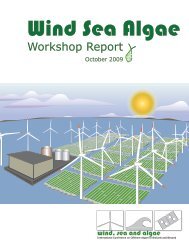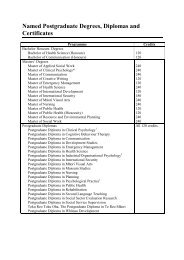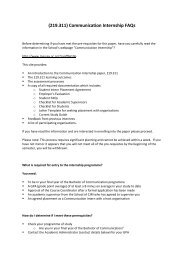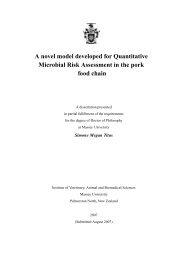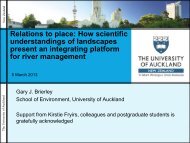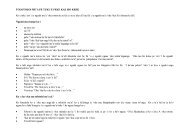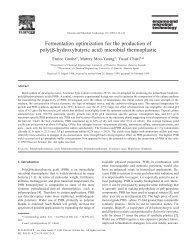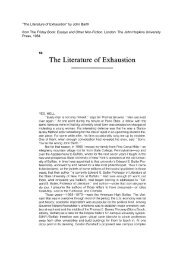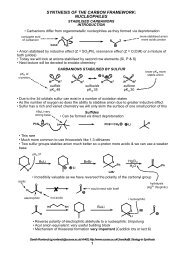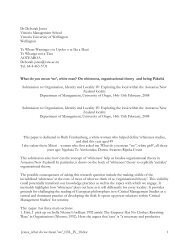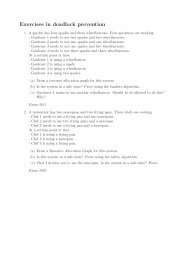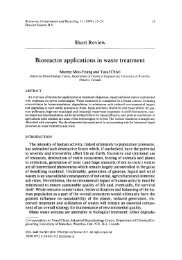NITROGEN MANAGEMENT BY WATERCRESS ... - Massey University
NITROGEN MANAGEMENT BY WATERCRESS ... - Massey University
NITROGEN MANAGEMENT BY WATERCRESS ... - Massey University
Create successful ePaper yourself
Turn your PDF publications into a flip-book with our unique Google optimized e-Paper software.
<strong>NITROGEN</strong> <strong>MANAGEMENT</strong> <strong>BY</strong> <strong>WATERCRESS</strong> (NASTURTIUM<br />
OFFICINALE) IN HYDROPONIC CONDITIONS<br />
Charlotte Robertson a,b , Brent Clothier a , Siva Sivakumaran a , Andrew McLachlan a ,<br />
Ian McIvor a , Heather Meikle b<br />
a Sustainable Production, The New Zealand Institute for Plant & Food Research Limited,<br />
Tennent Drive, Palmerston North, 4474<br />
b Science Department, Palmerston North Girls’ High School,<br />
238 Fitzherbert Avenue, Hokowhitu, 4410<br />
Abstract<br />
Nitrate uptake by hydroponically grown watercress (Nasturtium officinale) was quantified<br />
over a 10 week period to determine whether watercress could be used to manage nitrogen<br />
pollution in waterways.<br />
Germinated watercress was grown hydroponically in a glasshouse using a sterile Grodan®<br />
(rockwool) medium. A constant nutrient concentration and pH were maintained throughout<br />
the experiment. This involved regular (daily) determination of nutrient conductivity factor in<br />
the solution and addition of nutrients to compensate for plant uptake. Nitrate-nitrogen levels<br />
in the hydroponic solution were monitored weekly using an RFA-300 (Rapid Flow Analyser).<br />
Each week, 10 plants were randomly selected and destructively sampled for dry matter and<br />
total nitrogen (TN) determination. Plant nitrogen levels were quantified using a LECO<br />
Truspec C/N analyser.<br />
The distribution of TN throughout the plant was not uniform. TN content was highest in the<br />
leaves and least in the roots. Plant dry matter and TN content both increased in a similar,<br />
exponential-like manner between Days 28 and 56. Rate of increase of both plant mass and N<br />
uptake slowed after Day 56, although TN mass continued to increase as plant biomass<br />
increased. That is, if the plant was actively growing, it took up N. Leaf TN concentration<br />
peaked at 6–7% at Day 21, and slowly decreased to just over 4% on Day 70.<br />
To maximise TN removal, watercress should be harvested when the rate of nitrate uptake is at<br />
its maximum. In this experiment, this was at Day 32. This study needs repeating in field<br />
conditions in polluted waterways.<br />
Introduction<br />
Pollution, particularly by phosphates and nitrogenous compounds, is a key cause of excessive<br />
algal growth, loss of native aquatic flora and fauna, and deterioration of waterways. As a<br />
result, scientists and world leaders are increasingly concerned that there may not be enough<br />
clean water in the world to support humans in the future. Therefore society needs to learn to<br />
look after waterways better than has been practiced before, and to clean up what needs to be<br />
cleaned up. We therefore need to continually improve how we look after our waterways, and<br />
clean up polluted waterways where we can (Smith, 1999; Sorrell, 2010).<br />
The status of a freshwater ecosystem is often closely linked to human activity – industry,<br />
agriculture and human settlements are usually concentrated alongside waterways. The leading<br />
1
issues for waterway nutrient and sediment pollution are agriculture; town/city sewerage and<br />
industrial discharges; and river engineering (Chadwick, 2010).<br />
Waterways in New Zealand are also becoming increasingly polluted. For example, the<br />
Manawatu River has recently been classed as „unhealthy‟ and „heavily polluted‟ by world<br />
standards (Young, 2009). Results of tests on the Manawatu River‟s rates of Gross Primary<br />
Productivity (GPP) are among the highest internationally. In a 2009 report, Roger Young<br />
stated that “…sites with high rates of GPP are likely to experience algal blooms” (Young,<br />
2009). Toxic algal blooms are reported with increasing frequency in reaches of the Manawatu<br />
River and its tributaries (e.g. Mangatinoka River) (Young, 2009; Morgan & Burns, 2009).<br />
Many New Zealand waterways are polluted by excess nitrogen from farm runoff and human<br />
activities. Watercress (Nasturtium officinale), an edible aquatic herb belonging to the<br />
Brassicaceae (cabbage) family, is a „luxury feeder‟ that can grow rapidly and take up nitrogen<br />
in excess of its growth requirements Chapin (1980) and NIWA (2008). It could be an ideal<br />
plant to remove nitrogen from waterways (Vincent & Downes 1980). In this project we<br />
quantified how much nitrate the watercress plants could take up from hydroponic solution<br />
over 10 weeks, in order to determine whether watercress could be used to manage nitrogen<br />
pollution in waterways.<br />
Methods<br />
The trial was carried out in hydroponic runnels in the same glasshouse. A total of 200 plants<br />
were used; each plant was allocated a number 1 to 200. A random number generator was used<br />
to randomly select plants for analysis for the duration of the experiment.<br />
Germinated watercress was grown in a glasshouse hydroponically (Figures 1A and 1B) in a<br />
sterile Grodan® (rockwool) medium. The composition of the hydroponic nutrient solution is<br />
shown in Table 1.<br />
A constant nutrient concentration and pH were maintained in the hydroponic solution<br />
throughout the experiment. This was achieved by regular (daily) monitoring using a Bluelab<br />
CF/pH probe and meter; the nutrient solution concentration was adjusted to compensate for<br />
plant uptake. This ensured that plant nutrients such as nitrogen were always surplus to plant<br />
requirements and would not limit watercress growth during the trial. A CF of 15 was<br />
maintained. Hydroponic Solution was analysed weekly for nitrate-nitrogen using a RFA-300<br />
(Rapid Flow Analyser from Astoria-Pacific International, Clackamas, Oregon, U.S.A.).<br />
Each week, 10 plants were randomly selected and analysed for dry matter and total nitrogen<br />
(TN). Plant material was segregated into leaves, stems and roots and oven dried at 65°C for 3<br />
days prior to weighing to determine dry matter.<br />
TN was determined using a LECO Truspec C/N analyser. Representative sub-samples of<br />
plant material were sieved to
Table 1 Hydroponic Feed Solution<br />
Solution A (200 L) Solution B (200 L)<br />
Calcium Nitrate 30 kg Potassium Nitrate 10 kg<br />
Potassium Nitrate 5 kg Magnesium Sulphate 15 kg<br />
Ammonium Nitrate 500 g Mono-potassium<br />
phosphate<br />
3<br />
4 kg<br />
Iron Chelate –EDTA 384 g Potassium Sulphate 4 kg<br />
Iron Chelate –DTPA (6%) 416 g Manganous Sulphate 100 g<br />
Figure 1B:<br />
Watercress growing<br />
hydroponically at 42 days<br />
Zinc Sulphate 28 g<br />
Copper Sulphate 12 g<br />
Boric Acid 50 g<br />
Sodium Molybdate 2.5 g<br />
Figure 1A:<br />
Watercress growing<br />
hydroponically at 28 days
Results<br />
Plant Dry Matter and TN Uptake<br />
The distribution of TN throughout the plant was not uniform. The TN content was highest in<br />
the leaves and least in the roots (Figure 2).<br />
2.5<br />
2<br />
1.5<br />
1<br />
0.5<br />
0<br />
Figure 2: Total nitrogen (TN) content in watercress plant leaves, stems and roots from<br />
Days 42 to 70 (each data point is the average of 10 plants).<br />
Plant dry matter and TN content both increased in a similar, exponential manner between<br />
Days 28 and 56 (Figure 3).<br />
The rate of increase in plant mass and rate of nitrogen uptake slowed after Day 56. However,<br />
TN mass continued to increase as plant biomass increased. As long as the plant was actively<br />
growing, it took up nitrogen (Figure 3).<br />
Plant mass (g/plant)<br />
TN (g/plant)<br />
60<br />
50<br />
40<br />
30<br />
20<br />
10<br />
0<br />
40 50 60 70<br />
Plant mass<br />
Nitrogen mass<br />
Time (days)<br />
Figure 3: Change in total watercress plant dry mass (g/plant) and plant total nitrogen<br />
(TN) mass (g TN/g total plant mass) over the 70 days (average of 10 plants per data<br />
point).<br />
4<br />
Root Stem Leaves<br />
0 10 20 30 40 50 60 70<br />
Time (days)<br />
Total Nitrogen (g/plant)<br />
2.5<br />
2<br />
1.5<br />
1<br />
0.5<br />
0
Leaf TN concentration peaked at 6–7% at Day 21, and slowly decreased to just over 4% on<br />
Day 70 (Figure 4). Howard-Williams et al. (1981) also reported TN concentrations > 4% of<br />
the leaf dry mass, which is considered high for a plant.<br />
After Day 56, the mature watercress plants had absorbed approximately 2 g nitrogen per plant<br />
(dry matter was 42 – 46 g per plant).<br />
TN (% of plant)<br />
7<br />
6<br />
5<br />
4<br />
3<br />
2<br />
1<br />
0<br />
Leaves<br />
0 10 20 30 40 50 60 70<br />
Time (days)<br />
Figure 4: Total nitrogen (TN) content in watercress leaves and in the whole plant.<br />
Measurements compare %TN in plant mass from Days 0 to 70 (average of 10 plants per<br />
data point).<br />
Discussion<br />
Many rivers and streams are polluted by excessive nutrients. The Parliamentary<br />
Commissioner for the Environment stated that “… once nitrogen is leached to the<br />
environment there is no effective way to remove it – it is simply too late, and the<br />
consequences must be dealt with” (PCE, 2004). However, the findings of this research<br />
support the proposal that watercress could be useful to reduce nitrate levels in polluted<br />
waterways.<br />
As watercress is an edible salad herb, it could be harvested for human consumption, stock<br />
feed or used as a compost to form nutrient-rich fertiliser. Any of these options would allow<br />
the nitrate to be completely removed from the waterway.<br />
To maximise TN removal, watercress should be harvested when the rate of nitrate uptake is at<br />
its maximum. In this experiment, this was around Day 32. This date was based on an<br />
assessment of the derivative of the curve Figure 3. However, if plants are left to mature<br />
before harvesting, nitrogen toxicity could be an issue if used for stock or human<br />
consumption. Alternatively, leaves high in nitrogen could be used as nutrient-rich compost.<br />
This study needs repeating in field conditions in polluted waterways.<br />
5
Conclusions<br />
Watercress is an aquatic plant with the potential to grow rapidly in water and to take up large<br />
amounts of nitrate. We found the tissue TN concentration exceeded 4% during the active<br />
growth phase of the watercress.<br />
Watercress may therefore be an ideal plant to use to reduce nitrogen pollution in waterways,<br />
and there might even be business opportunities through the sale of the plant material.<br />
Watercress plants could therefore provide a sustainable means to remove nitrogen from<br />
waterways, reducing the deleterious consequences of nutrient pollution.<br />
Acknowledgements<br />
<strong>Massey</strong> <strong>University</strong>: Russell Death, Bob Toes, Ross Wallace Steven Ray, Lindsay Sylva,<br />
Lesley Taylor, Ewen Cameron and Peter Kemp; Hawke‟s Bay Regional Council: Ian Millner;<br />
AgResearch: Keith Betteridge; Manawatu Science and Technology Fair Committee:<br />
Catherine Bradley; Royal Society of New Zealand: Carol Pound; Thanks to Brad Hanson,<br />
Rosalind Robertson and Peter Robertson; Chris Dunlop, Plant & Food Research, Lincoln for<br />
analysing the hydroponic solution and plant samples.<br />
References<br />
Chadwick, D. H. 2010. Silent Streams. National Geographic – Water, Our Thirsty World.<br />
Vol. 217(4), pp. 116-131.<br />
Chapin, F. S. 1980. The mineral nutrition of wild plants. Annual Review of Ecology and<br />
Systematics. Vol. 11, pp. 233-260.<br />
Howard-Williams C, Davies J, Pickmere S. 1981. The dynamics of growth of , the effects of<br />
changing area on and nitrate uptake by watercress Nasturtium officinale R. Br. in a New<br />
Zealand stream. Journal of Applied Ecology 19(2): 589-601.<br />
Morgan J. & Burns, K. 2009. Manawatu River „among worst in the West‟. The Dominion<br />
Post, November 26.<br />
NIWA (National Institute of Water & Atmospheric Research). 2008. Watercress: one step to<br />
cleaner waterways? Accessed 23/08/2009. Retrieved from: http://www.niwa.co.nz/ourscience/freshwater/publications/all/wru/2008-28/watercress.<br />
PCE (Parliamentary Commissioner for the Environment). 2004. Growing for good, Intensive<br />
farming, sustainability and New Zealand‟s environment. Accessed 15/07/2011. Retrieved<br />
from: http://www.pce.parliament.nz/assets/Uploads/Growing-for-Good.pdf.<br />
Smith, V. H., Tilman, G. D., Nekola J. C. 1999. Eutrophication: impacts of excess nutrient<br />
inputs on freshwater, marine, and terrestrial ecosystems. Environmental Pollution, Vol.<br />
100, pp. 179-196.<br />
Sorrell, B. 2010. Chapter 8 Nutrients. In: (Eds) Peters, M. & Clarkson, B. Wetland<br />
restoration: a handbook for NZ freshwater systems. (Landcare Research), pp. 101-122.<br />
Vincent W. F, Downes M. T. 1980. Variation in nutrient removal from a stream by<br />
watercress (Nasturtium officinale R. Br.). Aquatic Botany 9(3): 221-235.<br />
Young, R. G. 2009. Hearings on submissions concerning the proposed one Plan notified by<br />
the Manawatu-Wanganui Regional Council. Section 42A. Report of Dr Roger Graeme<br />
Young on behalf of Horizons Regional Council.<br />
6



